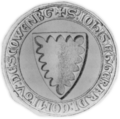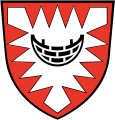Kiel coat of arms
|
State capital Kiel State of Schleswig-Holstein |
|
|---|---|

|
|
| Blazon | |
Red and white of the Hanseatic League |
|
| Basic data | |
| Introduction: | 1901 |
| Legal basis: | 1901: approval |
| Supporting documents: | May 14, 1901 coat of arms approval |
| Changes: | - |
| swell | |
|
1 main statute of the Schleswig-Holstein state capital Kiel (Article 1 Paragraph 2) |
|
The Kiel coat of arms is a centuries-old city coat of arms or symbol of the city of Kiel .
The crest
The coat of arms of the city of Kiel shows the so-called Holstein nettle leaf in silver on red with a black boat. The silver nettle leaf on a red background is the coat of arms of the Schauenburgers , who were enfeoffed with Holstein in 1110 . The brick boat, on the one hand the heraldic serves distinction, on the other hand symbolizes the city rights (by association with the walls) as well as the importance of the port for Kiel. The boat and the coat of arms with nettle leaf on the bow can be seen on the city's seals from the 13th century . This seal has changed over time. In the 14th century there were seals that served as the basis for the design of today's coat of arms. A seal with a nettle leaf floating above the ship dates from the 16th century.
The nettle leaf
The origin and meaning of the leaf are not clear. The most common view is that it is a nettle leaf. But there is also the theory that the leaf of the husk bush ( ilex ) is represented. Another theory says that the leaf symbolizes the Nettelberg , on which the Schauenburgers built their master palace in Rinteln on the Weser . However, the Schauenburgers originally had a lion and it was not until they were merchants of Holstein that the nettle leaf appeared in their coat of arms. The coat of arms of the aforementioned city in Lower Saxony also shows a nettle leaf.
In the opinion of the Kiel-born writer Detlev von Liliencron and the Hademarsch pastor Hans Treplin, the coat of arms is a Christian symbol: the three nails from the cross of Jesus Christ on the three corners of the embedded nettle leaf.
Seal of the Schauenburgs under Gerhard I and Johann I.
Seal of the Schauenburger under Gerhard III.
A more recent thesis is that the nettle leaf is derived as a figure from the shield fitting. According to the technique common in the Middle Ages , a serrated shield edge was set in order to fix the silver base or a metal shield fitting was placed over the red background through the division . As a result, the fitting could have emerged as a heraldic figure.
The nettle leaf is documented as a heraldic symbol for the first time in 1239. Adolf IV , who with his coalition troops in the battle of Bornhöved on July 22nd, 1227 recaptured Holstein from Waldemar II and founded Kiel in 1235, initially carried it next to the lion's coat of arms. Only his sons used it as the sole coat of arms. This change of coat of arms had political reasons: Denmark had three lions in its coat of arms, as it still does today. Schleswig as a Danish flag loan two. Adolf IV wanted to avoid that the country would be seen as a fief through associations, and so strengthen its connection to the empire.
Other cities in the region have also adopted the nettle leaf in their coat of arms (e.g. Bückeburg , Rinteln , Stadthagen , Barmstedt , Uetersen or Wedel ).
Today's coat of arms
For the first time, today's coat of arms can be found on a coat of arms frieze of the government building in Schleswig, which was built from 1876 to 1879 . It was in this building that it was accepted by the Prussian heraldry in 1901. But earlier forms are also known, such as one with a black heart shield in a silver nettle leaf, in which there is a golden boat.
See also
Web links
Footnotes
- ↑ Biogram Hans Treplin (online at geschichte-bk-sh.de)
- ^ Detlev Freiherr von Liliencron: The battle near Stellau. 1201. Novelle , Leipzig: Max Hesse 1906 - Chapter 1: “Eleven years ago, Count Adolf the Third answered the call of his imperial lord to take him back to the holy grave. The gigantic figure of the Holsteiner was generally noticed when he rode to the side of the broad-shouldered, medium-sized Kaiser; he towered over him by a head. The clever Friedrich Barbarossa, with his southern German cheerfulness and amiability, which remained the same in happiness and unhappiness, with his deep sense of humor, which the gloomy, sober Holsteiner was unable to understand, could not help teasing the count whenever the opportunity arose. But he was very fond of him. At Iconium , when the German king was showered with arrows from an elephant tower , Herr Adolf had climbed the rope ladders that had been forgotten to pull up on the mighty beast in the chaos of the battle, and had wreaked havoc under the pagan bred above. He alone. His good sword, which Timm, the armorer, hammered in his teeth, he was, using his right hand to reach into the ladder, his left hand holding up the shield with the three nails of Christ between the nettle leaves in the coat of arms, against the hail of bullets, boldly pushed up ” (online at projekt-gutenberg.org) . The Hademarsch pastor Hans Treplin (1884–1981) also reports on this tradition, even if he makes the mistake of saying Adolf III. and Adolf IV : “This pious count took part in a crusade to wrest the Holy Sepulcher in Jerusalem from the hands of the pagan Turks . He also returned home happy and brought a holy relic with him, namely the three nails from the cross of Golgotha ... The three particularly long, protruding points on the three corners [sc. of the coat of arms] mean the nails of the cross ... “(Hans Treplin: Around the village church , Breklum: Jensen 1964, p. 31 f.). Adolf IV is also occasionally - for various reasons - associated with the three nails in the Nesselblatt coat of arms: “Count Adolf IV, who became a monk and made a pilgrimage to Rome, led the three nails in the corners to commemorate the Crucifixion of the Savior, ie Jesus of Nazareth, “(in the Wikipedia article about the coat of arms of Schleswig-Holstein ). “It developed from a pure serrated border that was provided with three nails (Jesus was crucified with three nails) after Adolf IV's crusade to the Baltic States” (in the Wikipedia article on Holstein ).
- ↑ See: Dr. Walter Stephan in Zeitschrift für Schleswig-Holsteinische Geschichte, vol. 61, p. 1 ff., [1933] and vol. 63, p. 343 ff. [1935].





